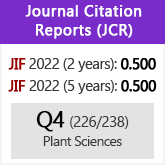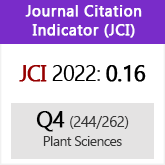The influence of environmental heterogeneity on the morphological and genetic diversity of Circaea lutetiana (Onagraceae) in Hyrcanian forests
DOI:
https://doi.org/10.3989/ajbm.2562Keywords:
Circaea lutetiana, environmental heterogeneity, gene flow, genetic diversity, Hyrcanian forestsAbstract
Environmental gradients are important factors that can potentially influence the genetic diversity and differentiation of populations. The present study examines the effect of environmental heterogeneity of the Hyrcanian forests on populations of Circaea lutetiana L. (Onagraceae). Using morphometrics, scanning electron microscopy (SEM) of leaf epidermis, and molecular markers, we analyzed genetic diversity and differentiation among nine populations from environmentally divergent habitats. Three different gene pools were observed. Our results indicate that the genetic structure is significantly correlated to environmental factors, but not to the geographical distance. Genetic clustering in C. lutetiana is affected by temperature, humidity, elevation, and average annual rainfall. Overall, our data indicate that gene flow does not contribute to explaining spatial patterns of genetic structure and the adaptation to the environment is the main factor shaping the genetic structure of the C. lutetiana populations. The populations belonging to each of the three gene pools have similarities in microclimate parameters, despite their geographical proximity, and populations from the same genetic pool can be up to 470 km apart. This evidence, as well as morphological and genetic similarities of the populations with greater geographical distance, suggest the possibility of cryptic speciation in this species.
Downloads
References
Ahmad P. & Prasad M.N.V. 2011. Abiotic stress responses in plants: metabolism, productivity and sustainability. Springer, New York.
Akhani H., Djamali M., Ghorbanalizadeh A. & Ramezani E. 2010. Plant biodiversity of Hyrcanian relict forests, N Iran: an overview of the flora, vegetation, palaeoecology and conservation. Pakistan Journal of Botany 42 (Special Issue): 231-258.
Antonovics J. & Bradshaw A.D. 1970. Evolution in closely adjacent plant populations. VIII. Glinal patterns at a mine boundary. Heredity 25: 349-362. https://doi.org/10.1038/hdy.1970.36
Bacles C.F. & Ennos R.A. 2008. Paternity analysis of pollen-mediated gene flow for Fraxinus excelsior L. in a chronically fragmented landscape. Heredity 101: 368-380. https://doi.org/10.1038/hdy.2008.66 PMid:18648389
Boufford D.E. 2005. Circaea lutetiana sensu lato (Onagraceae) reconsidered. Harvard Papers in Botany 9: 255-256.
Bradshaw A.D. 1965. Evolutionary significance of phenotypic plasticity in plants. Advances in Genetics 13: 115-155. https://doi.org/10.1016/S0065-2660(08)60048-6
Cain M.L., Milligan B.G. & Strand A.E. 2000. Long‐distance seed dispersal in plant populations. American Journal of Botany 87: 1217-1227. https://doi.org/10.2307/2656714 PMid:10991892
Collard B.C.Y. & Mackill D.J. 2009. Start Codon Targeted (SCoT) polymorphism: a simple novel DNA marker technique for generating gene-targeted markers in plants. Plant Molecular Biology Reporter 27: 86-93. https://doi.org/10.1007/s11105-008-0060-5
Cortés A.J., Monserrate F.A., Ramírez-Villegas J., Madriñán S. & Blair M.W. 2013. Drought tolerance in wild plant populations: the case of common beans (Phaseolus vulgaris L.). PLoS ONE 8: e62898. https://doi.org/10.1371/journal.pone.0062898 PMid:23658783 PMCid:PMC3643911
Dick C.A., Herman J.A., O'Dell R.E., Lopez-Villalobos A., Eckert C. & Whittall J.B. 2014. Cryptic genetic subdivision in the San Benito evening primrose (Camissonia benitensis). Conservation Genetics 15: 165-175. https://doi.org/10.1007/s10592-013-0533-4
Duarte J.F., de Carvalho D. & de Almeida Vieira F. 2015. Genetic conservation of Ficus bonijesulapensis RM Castro in a dry forest on limestone outcrops. Biochemical Systematics and Ecology 59: 54-62. https://doi.org/10.1016/j.bse.2015.01.008
Eckert C., Samis K. & Lougheed S. 2008. Genetic variation across species' geographical ranges: the central-marginal hypothesis and beyond. Molecular Ecology 17: 1170-1188. https://doi.org/10.1111/j.1365-294X.2007.03659.x PMid:18302683
Falush D., Stephens M. & Pritchard J.K. 2007. Inference of population structure using multilocus genotype data: dominant markers and null alleles. Molecular Ecology Notes 7: 574-578. https://doi.org/10.1111/j.1471-8286.2007.01758.x PMid:18784791 PMCid:PMC1974779
Fox G.A, Kendall B.E. & Schwinning S. 2012. Environmental heterogeneity and plants. Encyclopedia of Theoretical Ecology 258-263. https://doi.org/10.1525/9780520951785-049 PMid:30344065
Frankham R., Briscoe D.A. & Ballou J.D. 2002. Introduction to Conservation Genetics. Cambridge University Press, Cambridge. https://doi.org/10.1017/CBO9780511808999 PMid:12126990
Franks S.J. & Weis A.E. 2009. Climate change alters reproductive isolation and potential gene flow in an annual plant. Evolutionary Applications 2: 481-488. https://doi.org/10.1111/j.1752-4571.2009.00073.x PMid:25567893 PMCid:PMC3352446
Freeland J.R., Kirk H. & Peterson S.D. 2011. Molecular Ecology. 2nd ed. Wiley-Blackwell, Chichester, UK. https://doi.org/10.1002/9780470979365
Ghasemzadeh Baraki S., Nikzat Siahkolaee S. & Mousavi A. 2018. Optimization of the genomic DNA extraction in some mosses. Rostaniha 19: 165-175.
Hamasha H., Schmidt‐Lebuhn A., Durka W., Schleuning M. & Hensen I. 2013. Bioclimatic regions influence genetic structure of four Jordanian Stipa species. Plant Biology 15: 882-891. https://doi.org/10.1111/j.1438-8677.2012.00689.x PMid:23369254
Hammer Ø., Harper D. & Ryan P. 2001. PAST-palaeontological statistics, ver. 1.89. Palaeontologia Electronica 4: 1-9.
Hou Y. & Lou A. 2011. Population genetic diversity and structure of a naturally isolated plant species, Rhodiola dumulosa (Crassulaceae). PLoS ONE 6: e24497. https://doi.org/10.1371/journal.pone.0024497 PMid:21909437 PMCid:PMC3164725
Hufford K.M. & Mazer S.J. 2003. Plant ecotypes: genetic differentiation in the age of ecological restoration. Trends in Ecology & Evolution 18: 147-155. https://doi.org/10.1016/S0169-5347(03)00002-8
Hutchison D.W. & Templeton A.R. 1999. Correlation of pairwise genetic and geographic distance measures: inferring the relative influences of gene flow and drift on the distribution of genetic variability. Evolution 53: 1898-1914. https://doi.org/10.1111/j.1558-5646.1999.tb04571.x PMid:28565459
Kang H.W., Park D.S., Go S.J. & Eun M.Y. 2002. Fingerprinting of diverse genomes using PCR with universal rice primers generated from repetitive sequence of Korean weedy rice. Molecules and Cells 13: 281-287
Khan M.K., Pandey A., Thomas G., Akkaya M.S., Kayis S.A., Ozsensoy Y., Hamurcu M., Gezgin S., Topal A. & Hakki E.E. 2015. Genetic diversity and population structure of wheat in India and Turkey. AoB Plants 7: plv083. https://doi.org/10.1093/aobpla/plv083 PMid:26187605 PMCid:PMC4565425
Little C.J., Wheeler J.A., Sedlacek J., Cortés A.J. & Rixen C. 2016. Small-scale drivers: the importance of nutrient availability and snowmelt timing on performance of the alpine shrub Salix herbacea. Oecologia 180: 1015-1024. https://doi.org/10.1007/s00442-015-3394-3 PMid:26235963
Losos J.B. & Glor R.E. 2003. Phylogenetic comparative methods and the geography of speciation. Trends in Ecology and Evolution 18: 220-227. https://doi.org/10.1016/S0169-5347(03)00037-5
Medrano M. & Herrera C.M. 2008. Geographical structuring of genetic diversity across the whole distribution range of Narcissus longispathus, a habitat-specialist, Mediterranean narrow endemic. Annals of Botany 102: 183-194. https://doi.org/10.1093/aob/mcn086 PMid:18556752 PMCid:PMC2712358
Mitton J., Latta R. & Rehfeldt G. 1997. The pattern of inbreeding in Washoe pine and survival of inbred progeny under optimal environmental conditions. Silvae Genetica 46: 215-218.
Nevo E. 2001. Evolution of genome-phenome diversity under environmental stress. Proceedings of the National Academy of Sciences 98: 6233-6240. https://doi.org/10.1073/pnas.101109298 PMid:11371642 PMCid:PMC33451
Peakall R. & Smouse P.E. 2006. GENALEX 6: genetic analysis in Excel. Population genetic software for teaching and research. Molecular Ecology Notes 6: 288-295. https://doi.org/10.1111/j.1471-8286.2005.01155.x
Perrier X. & Jacquemoud-Collet J.P. 2006. DARwin software. Website: https://darwin.cirad.fr/ (Accessed Mar 15, 2011).
Podani J. 2000. Introduction to the exploration of multivariate biological data. Backhuys Publishers, Leiden.
Pole M. 2010. Cuticle morphology of Australasian Sapindaceae. Botanical Journal of the Linnean Society 164: 264-292. https://doi.org/10.1111/j.1095-8339.2010.01086.x
Pritchard J.K., Stephens M., Donnelly P. 2000. Inference of population structure using multilocus genotype data. Genetics 155: 945-959. https://doi.org/10.1093/genetics/155.2.945 PMid:10835412 PMCid:PMC1461096
Robertson A.W., Ladley J.J., Kelly D., McNutt K.L., Peterson P.G., Merrett M.F. & Karl B.J. 2008. Assessing pollination and fruit dispersal in Fuchsia excorticata (Onagraceae). New Zealand Journal of Botany 46: 299-314 https://doi.org/10.1080/00288250809509768
Schmitt J., Dudley S.A. & Pigliucci M. 1999. Manipulative approaches to testing adaptive plasticity: phytochrome-mediated shade-avoidance responses in plants. American Naturalist 154: S43-S54. https://doi.org/10.1086/303282 PMid:29586708
Slatkin M. 1985. Gene flow in natural populations. Annual Review of Ecology and Systematics 16: 393-430. https://doi.org/10.1146/annurev.es.16.110185.002141
Slatkin M. 1993. Isolation by distance in equilibrium and non‐equilibrium populations. Evolution 47: 264-279. https://doi.org/10.1111/j.1558-5646.1993.tb01215.x PMid:28568097
Spehn E.M. & Körner C. 2005. A global assessment of mountain biodiversity and its function. In Huber U.M., Bugmann H.K.M. & Reasoner M.A. (eds.), Global Change and Mountain Regions: 393-400. Springer, Dordrecht. https://doi.org/10.1007/1-4020-3508-X_39
Stearns S.C. 1989. Trade-offs in Life-history evolution. Functional Ecology 3: 259-268. https://doi.org/10.2307/2389364
Still D., Kim D.H. & Aoyama N. 2005. Genetic variation in Echinacea angustifolia along a climatic gradient. Annals of Botany 96: 467-477. https://doi.org/10.1093/aob/mci199 PMid:15994841 PMCid:PMC4246781
Struik G.J. 1965. Growth patterns of some native annual and perennial herbs in Southern Wisconsin. Ecology 46: 401-420. https://doi.org/10.2307/1934873
van der Meijden R. 1990. Heukels' flora van Nederland. 21ste druk. Wolters-Noordhoff, Groningen.
Verburg R.W., Kwant R. & Werger M.J.A. 1996. The effect of plant size on vegetative reproduction in a pseudo-annual. Vegetatio 125: 185-192. https://doi.org/10.1007/BF00044650
Verburg R., Maas J. & During H.J. 1998. Vegetative propagation and sexual reproduction in the woodland understorey pseudo-annual Circaea lutetiana L. Plant Ecology 134:211-224
Verburg R., Maas J. & During H.J. 2000. Clonal diversity in differently- aged populations of the pseudo-annual clonal plant Circaea lutetiana L. Plant Biology 2: 646-652. https://doi.org/10.1055/s-2000-16633
Wagner. W.L., Hoch P.C. & Peter H. 2007. Revised classification of the Onagraceae. Systematic Botany Monographs 83: 1-240.
Wagner W.L. & Hoch P.C. 2009. Nomenclatural Corrections in Onagraceae. Novon: A Journal for Botanical Nomenclature 19: 130-132. https://doi.org/10.3417/2008083
Weising K., Nybom H., Pfenninger M., Wolff K. & Kahl G. 2005. DNA Fingerprinting in Plants: Principles, Methods, and Applications. CRC Press, Boca Raton. https://doi.org/10.1201/9781420040043
Wheeler J.A., Schnider F., Sedlacek J., Cortés A.J., Wipf S., Hoch G. & Rixen C. 2015. With a little help from my friends: community facilitation increases performance in the dwarf shrub Salix herbacea. Basic and Applied Ecology 16: 202-209. https://doi.org/10.1016/j.baae.2015.02.004
Whitlock M.C. & McCauley D.E. 1999. Indirect measures of gene flow and migration: FST≠ 1/(4Nm+ 1). Heredity 82: 117-125. https://doi.org/10.1038/sj.hdy.6884960 PMid:10098262
Published
How to Cite
Issue
Section
License
Copyright (c) 2021 Consejo Superior de Investigaciones Científicas (CSIC)

This work is licensed under a Creative Commons Attribution 4.0 International License.
© CSIC. Manuscripts published in both the printed and online versions of this Journal are the property of Consejo Superior de Investigaciones Científicas, and quoting this source is a requirement for any partial or full reproduction.All contents of this electronic edition, except where otherwise noted, are distributed under a “Creative Commons Attribution 4.0 International” (CC BY 4.0) License. You may read here the basic information and the legal text of the license. The indication of the CC BY 4.0 License must be expressly stated in this way when necessary.
Self-archiving in repositories, personal webpages or similar, of any version other than the published by the Editor, is not allowed.

















